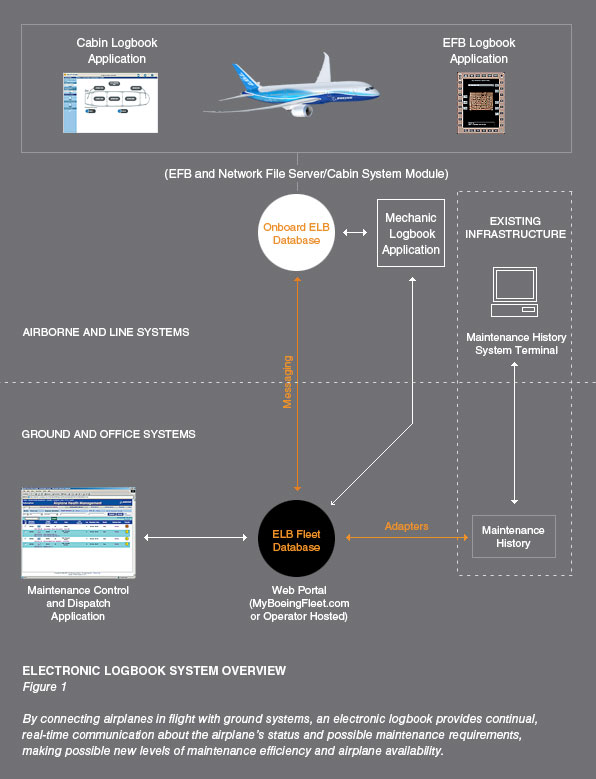
DEFINITION AND BENEFITS OF AN ELB
Airlines use a number of paper-based logbooks, including flight, technical, airplane maintenance, cabin, ground, and system-specific logs. These logs are used to record technical problems and maintenance resolution, provide flight crews with airplane status, and comply with regulatory recordkeeping requirements. But paper logbooks have a number of limitations. The paper logbook entries record the flight crew interpretation of the problem. These can vary widely depending on the flight crew. There is often no correlation to the fault code identification, and entries can be difficult to match with the system-generated fault messages. The Boeing ELB correlates entries automatically and provides standard nomenclature for problems.
An ELB system replaces paper logbooks with computer-based logs that can be easily stored and shared — even if users are thousands of miles apart (see fig. 1). At a minimum, an electronic logbook should do everything paper logbooks do today while making pilots’ logging tasks simpler and faster by providing easy-to-use, standardized fault-reporting tools. Regulatory and legal requirements mandate signoff of the log by the flight and maintenance crews. The Boeing ELB provides a U.S. Federal Aviation Administration (FAA)-approved method for this signoff, which does not require processes that might include a universal serial bus (USB) token or real-time validation.

An electronic logbook also may enhance an operator’s ability to plan unscheduled maintenance before the airplane arrives, coordinate logbook data with airplane-generated maintenance messages, and extend Airplane Health Management (AHM) capabilities beyond the central maintenance communication function to other types of faults. While AHM is not required for the ELB implementation, the combination of AHM and the ELB increases the value to the airline. (See “Remote Management of Real-Time Airplane Data,” AERO third-quarter 2007.) The system should enhance flight crew and mechanic work management and reduce the impact of nonroutine maintenance needs and the resulting schedule delays.
Boeing’s objective in developing electronic logbooks is to ensure coordinated data between flight and ground staff and increase maintenance efficiency. The integration of the system-generated faults with the pilot-reported faults could also reduce the no-fault-found (NFF) removals by providing additional information necessary to isolate the actual problem.

